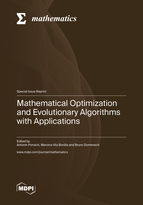Mathematical Optimization and Evolutionary Algorithms with Applications
A special issue of Mathematics (ISSN 2227-7390). This special issue belongs to the section "Engineering Mathematics".
Deadline for manuscript submissions: closed (16 December 2022) | Viewed by 31525
Special Issue Editors
Interests: multi-objective optimization; operations research; evolutionary computing; metaheuristics
Interests: combinatorial optimization; optimization of manufacturing systems; supply chain design
Interests: optimization of energy systems, multicriteria decision analysis, supply chain design
Special Issues, Collections and Topics in MDPI journals
Special Issue Information
Dear Colleagues,
Optimization is present almost everywhere in real life, resulting in a wide spectrum of scientific and engineering areas with applications that can be formalized as optimization problems. This variety of applications and the complexity of the studied phenomena have generated interest in developing appropriate and efficient solution strategies. Generally, two major classes of techniques emerge, namely, mathematical optimization and heuristics/metaheuristics, the latter one being broadly represented by evolutionary algorithms.
In this framework, this Special Issue invites authors to propose original works regarding the development of specific optimization models and solution tools, either based on mathematical techniques or on evolutionary algorithms, devoted to the treatment of scientific and engineering applications. Particular interest will be given to innovative works focusing on the design of mathematical/computational tools, as well as on specific applications requiring the adaptation and use of optimization techniques.
Topics include but are not limited to:
-- Novel mathematical programming models;
-- New evolutionary operators;
-- Constraint handling within evolutionary algorithms;
-- Multi-objective and many-objective optimization;
-- Hybrid algorithms and metaheuristics;
-- Logistics and production systems;
-- Operations research;
-- Engineering applications;
-- Energy systems;
-- Finance and economics;
-- Management;
-- Bioinformatics;
-- Machine learning.
Dr. Antonin Ponsich
Dr. Mariona Vila Bonilla
Dr. Bruno Domenech
Guest Editors
Manuscript Submission Information
Manuscripts should be submitted online at www.mdpi.com by registering and logging in to this website. Once you are registered, click here to go to the submission form. Manuscripts can be submitted until the deadline. All submissions that pass pre-check are peer-reviewed. Accepted papers will be published continuously in the journal (as soon as accepted) and will be listed together on the special issue website. Research articles, review articles as well as short communications are invited. For planned papers, a title and short abstract (about 100 words) can be sent to the Editorial Office for announcement on this website.
Submitted manuscripts should not have been published previously, nor be under consideration for publication elsewhere (except conference proceedings papers). All manuscripts are thoroughly refereed through a single-blind peer-review process. A guide for authors and other relevant information for submission of manuscripts is available on the Instructions for Authors page. Mathematics is an international peer-reviewed open access semimonthly journal published by MDPI.
Please visit the Instructions for Authors page before submitting a manuscript. The Article Processing Charge (APC) for publication in this open access journal is 2600 CHF (Swiss Francs). Submitted papers should be well formatted and use good English. Authors may use MDPI's English editing service prior to publication or during author revisions.
Keywords
- Mathematical optimization
- Evolutionary algorithms
- Engineering
- Applications







